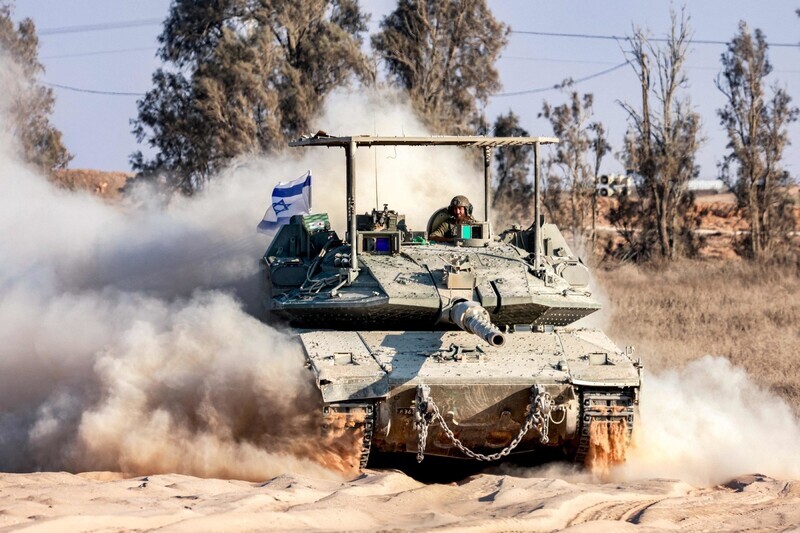Israel wins battles but loses the war

A man carries an injured child through Nuzeirat in central Gaza on July 14, 2024. Others have gathered around him at the UN-run school that Israel targeted in an airstrike. (Reuters/Yonhap)
Editor’s note: The war in the occupied Palestinian territory of Gaza, which began on October 7, 2023, continues to plunge the world into chaos and divide the international community into an ideological battlefield of the greatest magnitude since the Cold War. Israel has razed Gaza to the ground with US support, but is being dragged into a quagmire as it cannot end the war. This article examines the reality of the war in Gaza, which has reached its tipping point.
“These attacks are part of the continuous and changing military pressure that the Israeli forces are exerting in all parts of the Gaza Strip. Every day there are many deaths among Hamas terrorists… This is important for the systematic destruction of the terrorist organization Hamas.”
This was stated by Chief of Staff Herzi Halevi, Lieutenant General of the Israel Defense Forces (IDF), on Sunday, a day after Israeli forces launched an attack in Mawasi, a designated humanitarian zone, to kill Mohammed Deif, a leader of Hamas’ military wing. However, Halevi made this claim without confirming that Deif was dead. According to Gaza officials, 90 civilians were killed in the operation.
Israel is falling into a trap with its Gaza war.
Although more than nine months have passed since the war broke out on October 7 last year, Israel is still far from achieving its goal of wiping out Hamas, and the destruction caused by the war has only increased support for Hamas among the Palestinian population.
On Wednesday, July 10, the Israeli army ordered residents of Gaza City, the region’s largest city, to evacuate and called on civilians to evacuate to the south ahead of a “counter-terror operation” against Hamas and Palestinian Islamic Jihad, another Palestinian militant group.
At the beginning of the conflict, Israeli forces carried out a large-scale invasion of Gaza City in the northern Gaza Strip to evacuate most of its residents to the south and launch a purge against Hamas. Given the devastation of Gaza City at the time, Israel concluded that it had expelled Hamas.
But Hamas returned, and Israel is now again expelling the returning residents. On June 24, Israeli Prime Minister Benjamin Netanyahu said that the current intense phase of Israel’s fighting against Hamas in the Gaza Strip was “nearing an end” and mentioned the possibility of moving troops to the northern part of the region bordering Lebanon to fight Hezbollah there. These remarks cast a shadow over the declaration that large-scale fighting in the Gaza Strip had ended.
So far, Israel has deployed around 40,000 troops, turned 80 percent of Gaza’s 2.3 million inhabitants into refugees, killed at least 38,000 people (70 percent of them civilians) and dropped at least 70,000 tons of explosives – more than the amount dropped on London, Dresden and Hamburg during World War II. More than half of the buildings in the region have been destroyed, and water, electricity and fuel supplies have been cut off in an attempt to starve the residents.
The Gaza conflict has been in a kind of stalemate since April. In the initial phase, Israel attempted a north-south expansion, driving 1.2 million Gazans to Rafah at the southern end of the Strip to launch a maximum strike.
But Israel eventually backed down in the face of warnings and objections from the United States and other members of the international community, who feared civilian casualties. Around this time, even Western media began to claim that Israel had won the battles but lost the war.
In April, the New York Times concluded that Israel had “failed to achieve its main goals of the war: freeing the hostages and completely destroying Hamas.”
It also noted that “Palestinian suffering is undermining support (for Israel) even among its allies.”
Of the original 253 hostages, 109 were released in exchange for Palestinian prisoners during a week-long ceasefire last November. Since then, only three more have been freed through military operations, while another 12 have been found dead. Among the dead were three killed in Israeli military operations.
This means that a total of 129 hostages are still in prison, although according to Israel, at least 34 of them are also dead.

An Israeli tank drives along the border of the Palestinian territory of Gaza on July 14, 2024. (AFP/Yonhap)
Speaking before the Knesset, the Israeli parliament, Israeli Defense Minister Yoav Gallant said on Wednesday that 60% of Hamas fighters had been killed or injured. The Israeli military estimates that a total of 14,000 Hamas members have been killed so far, including 13,000 in April.
In an article in Foreign Affairs magazine titled “Hamas Wins,” Robert Pape, a professor at the University of Chicago, wrote last month that Hamas is in strong shape and its support among citizens is growing.
Hamas itself has estimated its losses at between 6,000 and 8,000, while US intelligence estimates the figure to be around 10,000. Hamas is still able to mobilize around 15,000 members in Gaza, and 80 percent of its tunnels in the region remain operational.
One of the reasons given by Pape for declaring Hamas victorious was that although Hamas has lost many members, it is still able to fill its ranks – an ability that is based on growing support among the local population. According to a survey by the Palestinian Center for Policy and Survey Research, support for Hamas has doubled since the surprise Israeli attack that sparked the conflict on October 7.
Before that attack, support for Hamas was around 20 percent in June 2023, a similar level to that of the rival Fatah party that controls the West Bank. A year later, in June of this year, the figures were 40 percent and 20 percent, respectively.
A poll conducted in March found that 73 percent of the Palestinian population believed that Hamas’s attack in October 2023 was justified, with 53 percent even saying they would support attacks on Israeli civilians.
The reasons for this lie in the suffering and tragedies that residents have had to endure since the beginning of the war in Gaza at the hands of Israel. 60 percent of Gaza residents had lost at least one family member; 75 percent had family members who had been injured or killed.
Another danger for Israel in the Gaza conflict is that there is neither a post-war plan nor an exit strategy.
In late May, Israeli security adviser Tzachi Hanegbi predicted that fighting in Gaza would continue throughout 2024, or “at least another seven months.” Not only has Israel failed to achieve its goals in the war, but Netanyahu would have to step down once it ends, and Israel has no plan or justification for ending it. In fact, the plan is to wait and see the outcome of the US presidential election in early November.
The US government under Joe Biden would like to hand over control of Gaza to the Palestinian Authority, which also controls the West Bank. But Netanyahu and his far-right cabinet are firmly opposed to this.
Far-right politicians such as National Security Minister Itamar Ben-Gvir are calling for the complete occupation of Gaza and its conversion into Israeli territory. Netanyahu has stated that this is not his own position – but Israel keeps pushing the reality of Gaza in this direction.
Since the end of last year, Israel has been laying the groundwork for a permanent military occupation by establishing a kilometer-wide buffer zone in a corridor running through the outer and central Gaza Strip.
For the residents of the Gaza Strip, the creation of this buffer zone in and around an area of only about 40 kilometers long and 5 to 12 kilometers wide meant a significant reduction in their territory as well as their practical demarcation and isolation.
Eyal Lurie-Pardes, a researcher at the Middle East Institute in Washington DC, said Israel’s main goal was the West Bankization of the Gaza Strip.
Because Israel occupies and partitions over 60 percent of the West Bank – which would otherwise be the territory of an independent Palestine – Palestinian residents are isolated within a fragmented region.
Hani Awad, a researcher at the Doha Institute, said Israel’s goal was to ethnically cleanse as many Palestinian residents as possible.
Israeli news agencies reported that the country is currently withdrawing its troops from Gaza and stationing them on the northern border with Lebanon to prepare for a full-scale clash with the Shiite militant group Hezbollah.
At the beginning of the Gaza conflict, Israel entered into a clash with Hezbollah to fend off criticism from the international community, but this resulted in 100,000 of its own citizens ending up as refugees in the north. Now a full-scale conflict with Hezbollah looks like a trap that Israel will find hard to escape.
With its endless war in the Gaza Strip and the current escalation with Hezbollah, Israel is essentially caught in a double trap.
By Jung E-gil, Senior Editor
Please direct any questions or comments to ([email protected])



